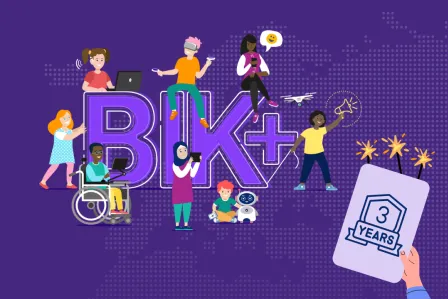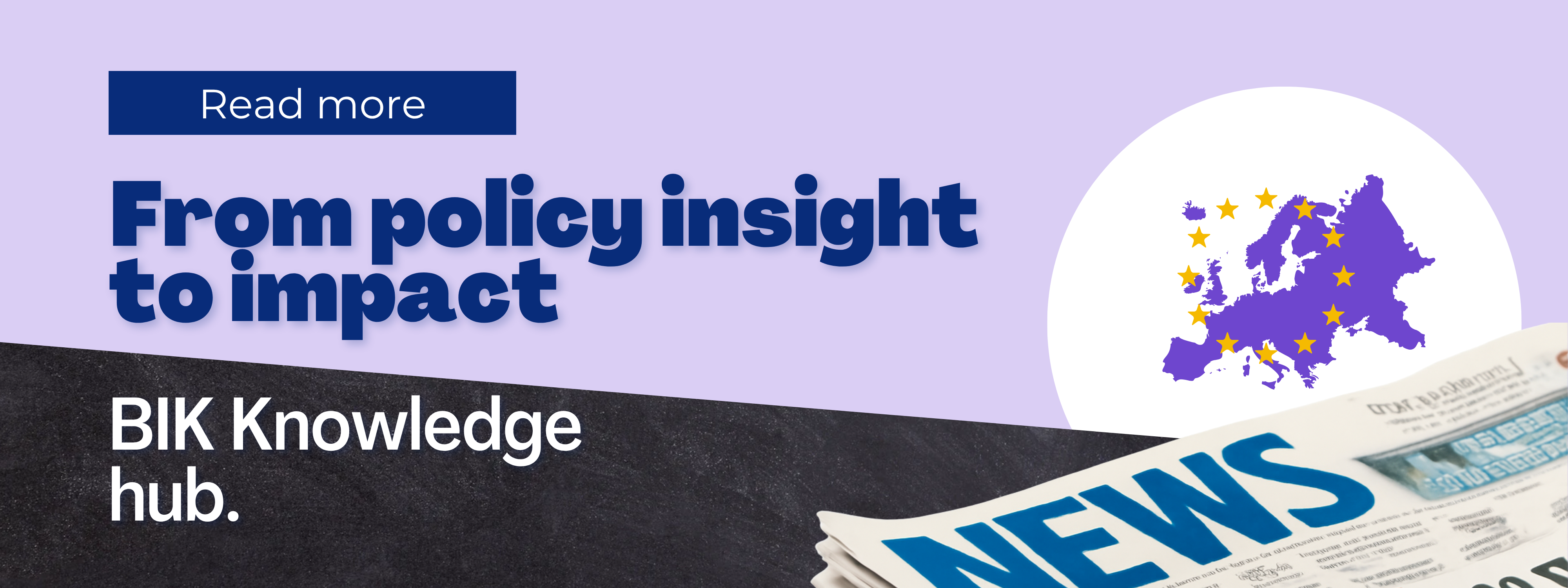Three years ago, the European Commission adopted a new European strategy for a Better Internet for Kids (BIK+), to improve age-appropriate digital services and to ensure that every child is protected, empowered and respected online. We take this opportunity to reflect on the impact of the BIK+ strategy three years after its adoption, and to look at the many policy developments that have happened over the course of the past year.

What is the BIK+ strategy?
The European strategy for a Better Internet for Kids (BIK+) aims for accessible, age-appropriate and informative online content and services that are in children's best interests. It complements and supports the implementation of the EU legal framework, notably of the the Audiovisual Services Directive (‘AVMSD’) and of the Digital Services Act (‘DSA’).
It was first adopted on 11 May 2022, and builds on the first European Strategy for a Better Internet for Children (BIK). As much has changed technologically and in EU legislation since 2012, a compendium of relevant legislation is available.
The vision behind the BIK+ strategy is to provide age-appropriate digital services where every child in Europe is protected, empowered, and respected online, ensuring that no one is left behind. The BIK+ strategy proposes actions around three pillars:
- Safe digital experiences - protecting children from harmful and illegal online content, conduct, and risks. The aim is to improve young people's well-being online through a safe, age-appropriate digital environment, created in a way that respects children’s best interests.
- Digital empowerment - enabling all children (including those in situations of vulnerability) to acquire the necessary skills and competences to make sound choices and express themselves safely and responsibly online.
- Active participation - respecting children by giving them a say in the digital environment, with more child-led activities to foster innovative and creative safe digital experiences.
Because youth empowerment and participation are at the core of the BIK+ strategy, a child-friendly version of the strategy is available in all EU languages, Icelandic, Norwegian, Serbian, Turkish and Ukrainian. In addition, the support children’s active participation in policymaking, and to respect their views on the digital environment, a child-led evaluation of the BIK+ strategy is foreseen every two years.
The BIK+ strategy evaluation
In 2024, we started evaluating the strategy’s progress and successes - as well as identifying challenges and key recommendations for future improvements - in the first two years since its adoption.
We evaluated the strategy’s progress and impact by consulting with a wide range of children and young people, teachers and educators, parents and caregivers, and other stakeholder groups in the BIK ecosystem across Europe.
At the heart of this extensive consultative work lies the great support of the Safer Internet Centres network across the EU, Albania, Iceland, North Macedonia and Norway, that facilitated consultations with children and young people. We learned directly from them what worked well and what brought about palpable positive change to their digital lives. A special mention goes to the BIK Youth Ambassadors for their active involvement in several stages of the evaluation process, and to various external research consultants providing expert guidance on the methodology and consultation protocol. Lastly, several COFACE Families Europe member organisations supported us during the consultations with parents and caregivers.
On Safer Internet Day 2025, the European Commission published a first version of the evaluation report of the BIK+ strategy, a review of the EU’s commitment to creating a safe and empowering digital environment for children and young people. Now, on the occasion of the third anniversary of the BIK+ strategy, the full version of the evaluation report of the BIK+ strategy is published. This report provides a summary of the consultations with children, young people, expert stakeholders, teachers, and parents, as well as general reflections on progress and success, persistent and emerging challenges, actions and aspirations for the future.
Read more about the BIK+ strategy evaluation report.
The 2025 BIK Policy monitor report
Since 2014, the Better Internet for Kids (BIK) Policy monitor (previously known as the BIK Policy map) has been tracking how EU countries support children’s and young people’s digital experiences. Since its launch over a decade ago, the main objective of this series has been to compare and exchange knowledge on policies and actions across EU Member States, Iceland and Norway that promote children's safety and well-being in the digital environment based on the recommended measures of the BIK+ strategy.
In May 2025, as BIK+ celebrates its third anniversary, we are publishing the sixth report of this series . It provides annually updated data, which is made possible by BIK Policy monitor national contacts and policy experts in each country, alongside the constant support of the European network of Safer Internet Centres.
In its latest edition, the BIK Policy monitor Report highlights progress as well as gaps in BIK+ policies, details actions taken under the BIK+ framework, and showcases the BIK+ strategy in practice across all 27 EU Member States, Iceland, and Norway. In doing so, this high-level comparative report represents one of the key features informing the policy work at the EU and national levels that constitute the Knowledge Hub on the BIK platform - a central access point for information, evidence, and policy insights on the impact of digital transformation on the lives of children and young people in the EU, Iceland, and Norway.
Read more about the 2025 BIK Policy monitor report on the BIK portal. Previous BIK Policy monitor/map reports are available in the archive.
Subscribe to the BIK bulletin to stay tuned for the forthcoming releases and additional updates related to the BIK Knowledge hub and the BIK+ strategy, alongside other pertinent news.

Three years ago, the European Commission adopted a new European strategy for a Better Internet for Kids (BIK+), to improve age-appropriate digital services and to ensure that every child is protected, empowered and respected online. We take this opportunity to reflect on the impact of the BIK+ strategy three years after its adoption, and to look at the many policy developments that have happened over the course of the past year.

What is the BIK+ strategy?
The European strategy for a Better Internet for Kids (BIK+) aims for accessible, age-appropriate and informative online content and services that are in children's best interests. It complements and supports the implementation of the EU legal framework, notably of the the Audiovisual Services Directive (‘AVMSD’) and of the Digital Services Act (‘DSA’).
It was first adopted on 11 May 2022, and builds on the first European Strategy for a Better Internet for Children (BIK). As much has changed technologically and in EU legislation since 2012, a compendium of relevant legislation is available.
The vision behind the BIK+ strategy is to provide age-appropriate digital services where every child in Europe is protected, empowered, and respected online, ensuring that no one is left behind. The BIK+ strategy proposes actions around three pillars:
- Safe digital experiences - protecting children from harmful and illegal online content, conduct, and risks. The aim is to improve young people's well-being online through a safe, age-appropriate digital environment, created in a way that respects children’s best interests.
- Digital empowerment - enabling all children (including those in situations of vulnerability) to acquire the necessary skills and competences to make sound choices and express themselves safely and responsibly online.
- Active participation - respecting children by giving them a say in the digital environment, with more child-led activities to foster innovative and creative safe digital experiences.
Because youth empowerment and participation are at the core of the BIK+ strategy, a child-friendly version of the strategy is available in all EU languages, Icelandic, Norwegian, Serbian, Turkish and Ukrainian. In addition, the support children’s active participation in policymaking, and to respect their views on the digital environment, a child-led evaluation of the BIK+ strategy is foreseen every two years.
The BIK+ strategy evaluation
In 2024, we started evaluating the strategy’s progress and successes - as well as identifying challenges and key recommendations for future improvements - in the first two years since its adoption.
We evaluated the strategy’s progress and impact by consulting with a wide range of children and young people, teachers and educators, parents and caregivers, and other stakeholder groups in the BIK ecosystem across Europe.
At the heart of this extensive consultative work lies the great support of the Safer Internet Centres network across the EU, Albania, Iceland, North Macedonia and Norway, that facilitated consultations with children and young people. We learned directly from them what worked well and what brought about palpable positive change to their digital lives. A special mention goes to the BIK Youth Ambassadors for their active involvement in several stages of the evaluation process, and to various external research consultants providing expert guidance on the methodology and consultation protocol. Lastly, several COFACE Families Europe member organisations supported us during the consultations with parents and caregivers.
On Safer Internet Day 2025, the European Commission published a first version of the evaluation report of the BIK+ strategy, a review of the EU’s commitment to creating a safe and empowering digital environment for children and young people. Now, on the occasion of the third anniversary of the BIK+ strategy, the full version of the evaluation report of the BIK+ strategy is published. This report provides a summary of the consultations with children, young people, expert stakeholders, teachers, and parents, as well as general reflections on progress and success, persistent and emerging challenges, actions and aspirations for the future.
Read more about the BIK+ strategy evaluation report.
The 2025 BIK Policy monitor report
Since 2014, the Better Internet for Kids (BIK) Policy monitor (previously known as the BIK Policy map) has been tracking how EU countries support children’s and young people’s digital experiences. Since its launch over a decade ago, the main objective of this series has been to compare and exchange knowledge on policies and actions across EU Member States, Iceland and Norway that promote children's safety and well-being in the digital environment based on the recommended measures of the BIK+ strategy.
In May 2025, as BIK+ celebrates its third anniversary, we are publishing the sixth report of this series . It provides annually updated data, which is made possible by BIK Policy monitor national contacts and policy experts in each country, alongside the constant support of the European network of Safer Internet Centres.
In its latest edition, the BIK Policy monitor Report highlights progress as well as gaps in BIK+ policies, details actions taken under the BIK+ framework, and showcases the BIK+ strategy in practice across all 27 EU Member States, Iceland, and Norway. In doing so, this high-level comparative report represents one of the key features informing the policy work at the EU and national levels that constitute the Knowledge Hub on the BIK platform - a central access point for information, evidence, and policy insights on the impact of digital transformation on the lives of children and young people in the EU, Iceland, and Norway.
Read more about the 2025 BIK Policy monitor report on the BIK portal. Previous BIK Policy monitor/map reports are available in the archive.
Subscribe to the BIK bulletin to stay tuned for the forthcoming releases and additional updates related to the BIK Knowledge hub and the BIK+ strategy, alongside other pertinent news.

- Better Internet for Kids (BIK+) strategy
Related content
- < Previous article
- Next article >











